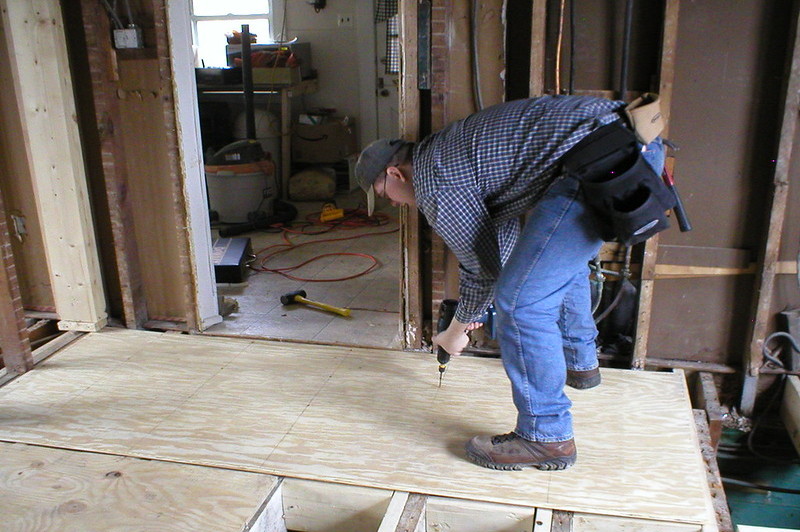Water-damaged subfloors need to be dried, repaired, and replaced immediately. Read on for an in-depth tutorial on how to repair water damaged subflooring.

What happens when subflooring gets wet?
The subfloor is one of the essential parts of your home. It’s where the floor covering and underlayment rests. You, your furniture, and your pets can walk on the final flooring thanks to the subfloor.
Since the subfloor is usually a plywood material, it is prone to water damage. Water damage happens when the subfloor gets wet. Whether it’s a broken pipe, a flood, or even too-cold air conditioning, it can harm your subfloor.
When water and moisture get in contact with the subfloor, molds and rotting can happen. Your floors can become squeaky and cracked. With significant water damage, your flooring can even sink when you step on them.
That’s why it’s essential to look out for these signs of water damage. When you notice these signs, you need to repair the water damage as soon as possible
How Do You Repair Water Damaged Subflooring?
If the damage is minimal, there are ways to fix the subfloor on your own. Read on to learn how.
Step #1. Preparation
The first step in repairing your subfloors is identifying where the water is coming from. Usually, water damage in subfloors is from leaking pipes, sinks, and water from floods.
If leaks cause water damage, you need to stop the leak before making any repairs. Let the area dry a bit before working on the repairs.
Next, you’ll need to pull back your carpeting. When the final flooring is exposed, you’ll have to remove this and the underlayment to expose the subfloor.
Remove these layers carefully to access the subfloor. Remember, you’ll need to put these layers back in place.
Step #2. Making the repairs
Now that you can see the subflooring, map out the parts that need repairs. Use chalk or any marker to indicate the water-damaged areas.
You’ll need to make the markings a bit bigger than usual. You have to include surfaces beyond the water-damaged areas. As much as possible, mark until the nearest adjacent floor joist.
Put on your gloves, goggles, and dust mask; it’s time to cut out the damaged subfloor. Using a circular saw set to an inch’s depth, follow the marks that you made. Make sure to be careful!
With a pry bar, gently pry the damaged subfloors away. If you see any loose nails, dispose of them along with the damaged subflooring.
Place the damaged subflooring and other debris in a sturdy trash bag. Don’t forget to throw these away properly later.
A vacuum can clean out all the remaining dust, wood particles, and debris from the subflooring. Make sure that the water-damaged area is clean before moving on to the next step.
Leave the subflooring to dry for a few days. To speed up the drying time, you can use large fans and dehumidifiers. Place them near the affected subflooring.
Step #3. Finishing touches
You’ll need to check the affected area frequently. Once it’s completely dry and free from molds, it’s now time for the finishing touches.
Begin by reinforcing the water-damaged floor joists. You can strengthen them by putting a 2-inch by 6-inch wooden slab next to the floor joists.
Once the reinforcements are complete, you can now reinstall the subflooring. Make sure to use a new subflooring material cut to the appropriate size.
Leave an eighth of an inch allowance in case the subflooring material expands. Attach the new subflooring using galvanized nails or deck screws.
Now you can put all the layers back in place. Start with the underlayment, then the floor covering. Finally, put the carpet back in place.
How much is the cost to fix a water-damaged subfloor?
Fixing a water-damaged subfloor is a big project. Repairing subfloors takes a lot of time, effort, and resources. Repairs can range from 500 to 700 dollars.
However, homeowner’s insurance can cover some of the subflooring repair expenses. Most of the time, damage caused by flooding and sudden events is under insurance coverage. Just be sure to consult with your contractor and insurance provider for complete details.
When should you replace your subflooring?
Water damage on your subflooring is a serious issue. It can affect the integrity of your floors, as well as your entire house. That’s why you need to address any signs of water damage on your subfloors as soon as possible.
If you notice any squeaking sounds, cracked tiles, or sinking areas on your floors, that’s probably a sign of water damage. Leaking pipes and a leaking sink are also a cause of concern.
While it’s cheaper to check for water damage yourself, it’s best to call a professional. Flooring experts can properly assess and repair your subfloors.
Conclusion
Since the subflooring is an integral part of your house, it’s important to keep them in tip-top shape. It’s best to notice the signs of water damage and make the appropriate repairs early on. Luckily, you already know how to repair water-damaged subflooring.
